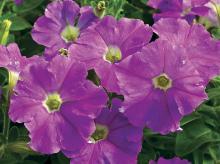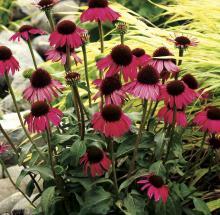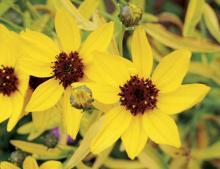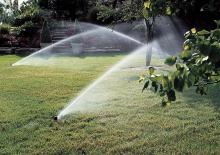 |
Annuals, like these petunias, only last for a single season.
|
 |
Perennials, like Echinacea, can survive over the winter and come back from their roots the following spring.
|
 |
This Coreopsis does best in full sun.
|
 |
The best time to water your lawn is in early morning or late evening when the sun is the weakest.
|
|
|
Annuals will grow, bloom and die all in one season. Typically we use annuals in areas here we want a LOT of colour, as they will flower all season. Perennials will live for many years, they grow and bloom and after winter they come back from the roots. Perennials usually flower for only a part of the season and will be 'vegetative' (i.e. green leaves only) when not in bloom.
First make sure you know what you have is it deep most of day shade, or is it burning hot most of day, or some combination of sun and shade. Once you know the conditions then match up the plants that best fit. As example, petunias are great flowers for sun gardens, while most ferns prefer shade. Plant tags a are good source of info, look at our plant resource area for articles on sun/shade gardens and plants. Regarding house exposure the south or southwest facing houses often have not only sun but also heat to contend with. We see that in hot gardens it is more important to make sure you have good organic mater in the soil, and are using a mulch to help keep your flowers watered. Remember that eight cm of mulch will reduce your watering, keep soil temps cooler, and reduce weeds!
Typically most plant foods suggest you use them every four to six weeks, more frequently if they are water soluble (that is they mix with water and are applied as liquids). Reading the directions of your plant food is a good start. We also are great fans of the 'feed at half strength and twice as often' school of plant food. If you have the time, cut the rate of the fertilizer in half, then apply it more frequently. This reduces the risk of burning the lawn or plants with too strong a food, and gives a more uniform feeding so there will be less dramatic fluctuation in plant growth. All you need to make this plan work is a little more time.
We have several good articles on watering on the site. A good rule of thumb is about 3-4 cm a week of water, less in cool times of year, maybe a bit more in heat of summer. The key to using less water is to not waste it. A few ideas:
- Only water in the morning or evening, not in the hot sun (to reduce loss due to evaporation)
- When you water, water deeply to get the roots to grow down, avoid light 'sprinklings'
- Use drip irrigation on trees and flowers versus overhead sprinklers - this puts the water right where it belongs
- Use mulch to keep water in (and weeds out)
Annuals often are either cool or warm season flowers. Pansies are the best known of annual flowers that will flower while the night temps are low, but sort of poop out when the summer heat starts. While some of the heat loving plants will not do well early in spring when it is cool, coleus, New Guinea impatiens and vinca are some well-known warm season plants. For a great looking annual flower bed many folks plan a 'change-out' mid summer. Plant the cool flowers early in spring, say late April, then by end of June come back in with the warm flowers.
Well, of course you have sunflowers (Helianthus), which range from 16 inches to 15 feet tall! Here are some others: cockscomb (Celosia) (30 in.), cornflower (Centaurea) (3-4 ft.), cleome (4 ft.), strawflower (Helichrysum) (14 in. to 4 ft.), salvia (14-20 in.), snapdragon (Antirrhinum) (16 in. to 4 ft.), zinnia (10 in. to 2 1/2 ft.).
Funny question, as the answer is it depends on how much in a hurry you are. Most baskets will hold four to six small plants, say the size you buy in spring in a cell-pack. If you are in a big hurry to have a full basket, plant 6 or more. If you have some patience then three to four is loads.
The frost free date in Southern Ontario varies per location, but historically May 24 is the start of the safe time to plant all annuals. However, cool temperature-loving annuals such as pansies can go into the garden well ahead of the 24th! Different annuals have different tolerances to cold temperatures. We like snaps, viola, dianthus, and pansies early, ahead of the warmer weather.
Some plants are just plain hungry, and the petunia, especially the spreading types such as Wave, really need to be fed. We think petunias can be fertilized about twice as heavily as other annual flowers. We really like to use a time-release food in the soil AND a liquid food every two weeks. If you feed heavy all summer you will avoid the yellow petunia leaf. Some other annuals are light feeders, the most famous of which is the New Guinea impatiens. With these plants, we like going the other way — feeding them at a lower rate, maybe half as much as recommended. A overfed New Guinea impatiens will be very green and have loads of leaves with not as many flowers as you would like.
Generally the rule of thumb with shrubs is to prune them after they have flowered. So, for spring flowering shrubs such as mock orange or lilacs, if you prune them in winter you will cut off the flowers, so waiting till after the flower is usually best.
|
|




